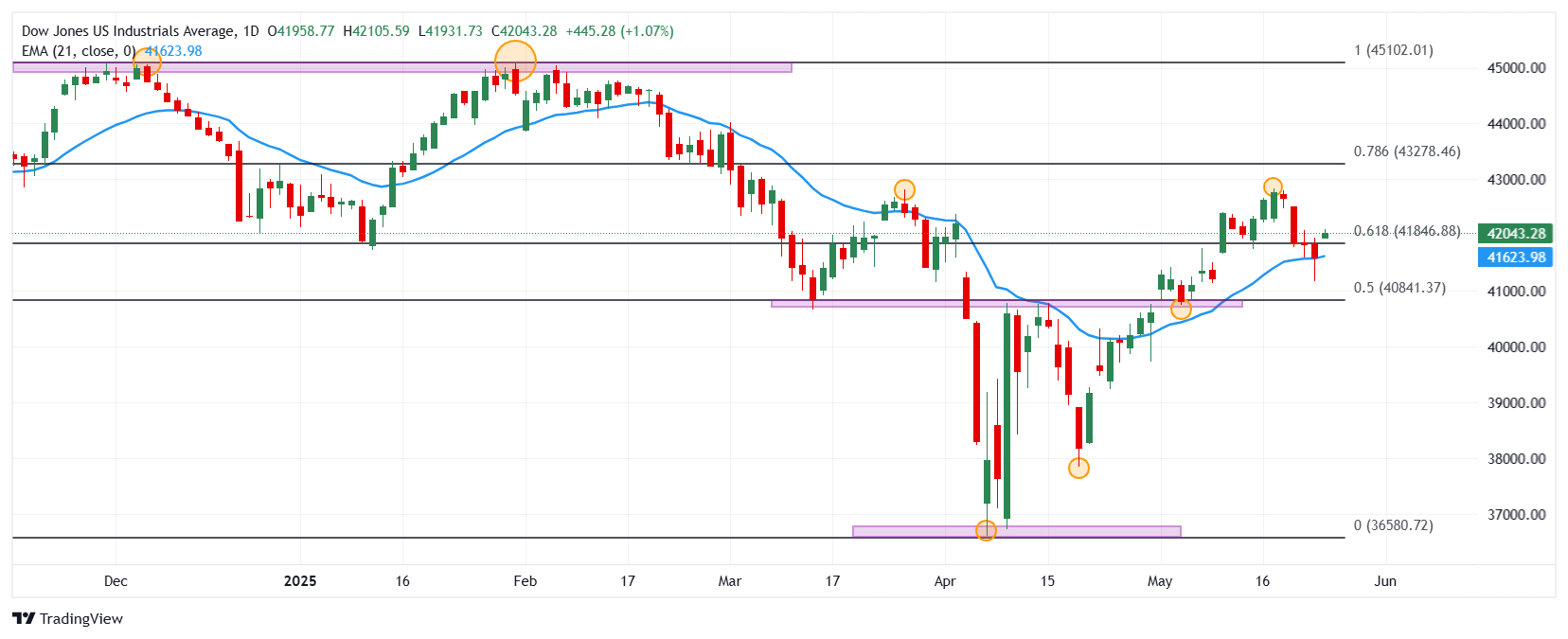- The Dow Jones advances 1.25% today, reaching maximum of May 21 in 42,105.
- The Nasdaq 100 rises 1.43% daily, reaching maximum of two days in 21,238.
- The S&P 500 rises 1.23% in the day, operating when writing about 5,872.
- The president of the United States, Donald Trump, announces a postponement in tariffs of 50% to the European Union, until July 9.
The Dow Jones marked a daily minimum in 41,931, attracting buyers who promoted the maximum index of May 21 in 42,105.
The Dow Jones industrial average began operating in 41,931, while the Nasdaq 100 technological index began negotiations in 21,055. The S&P 500 opened in 5,848, taking up the upward perspective.
The Dow Jones closes with profits in the middle of a limited session
The Dow Jones index wins 1.25% on Monday’s first day, currently quoting in 5,873.
The share market in the United States remained without operation today due to the “Day Memorial”, in observance to the fallen military personnel serving the Armed Forces.
In this context, Dow Jones closes with 72 gain points, up 1.25%, ending with four consecutive sessions with losses.
The Nasdaq 100 maintains the focus on the Nvidia profit report
The Nasdaq 100 technological index rises 1.47% on Monday, operating currently over 21,221.
The president of the United States, Donald Trump, announced that he will carry out a delay in the tariff application between his government and the EU, this after establishing negotiations with the president of the European Commission, Ursula von der Leyen. 50% tariffs on goods from Europe are postponed to July 9.
In this scenario, the Nasdaq 100 rebounds 302 points, reaching maximums of May 22 in 21,238.
The S&P 500 concentrates its attention on the key economic data of the week
Investor’s gaze will be put in the publication of FOMC minutes on Wednesday, May 28. Subsequently, on Thursday, May 29, the preliminary gross domestic product of the first quarter of the year will be announced, the consensus hopes that the figure of the anterior quarter at -0.03%.
The economic agenda also considers the US personal consumption expenses index for Friday, May 30. Analysts project that it is 0.1% in April, slightly higher the previous month.
The S&P 500 advances 69 points, cutting a streak of four consecutive days down, rising 1.19%, reaching May 21 in 5,879.
Technical Analysis of Dow Jones
The Dow Jones reacted down from a short -term resistance given by the maximum of May 19 in 42,832. The next key resistance is observed at 45,068, pivot point of January 31. Down, the closest support is located at 40,747, minimum of May 6, in convergence with the 50% fibonacci setback.
Dow Jones daily graphics

Dow Jones Faqs
The Dow Jones Industrial Avenge, one of the oldest stock market indexes in the world, consists of the 30 most negotiated values in the United States. The index is weighted by the price instead of capitalization. It is calculated by adding the prices of the values that compose it and dividing them by a factor, currently 0.152. The index was founded by Charles Dow, also founder of the Wall Street Journal. In recent years it has been criticized for not being sufficiently representative, since it only follows 30 companies, unlike broader rates such as S&P 500.
There are many factors that promote the Dow Jones Industrial Average (DJIA) index. The main one is the added performance of the companies that compose it, revealed in the quarterly reports of business benefits. The American and world macroeconomic data also contribute, since they influence investor confidence. The level of interest rates, set by the Federal Reserve (FED), also influences the DJia, since it affects the cost of credit, on which many companies depend largely. Therefore, inflation can be a determining factor, as well as other parameters that influence the decisions of the Federal Reserve.
Dow’s theory is a method to identify the main trend of the stock market developed by Charles Dow. A key step is to compare the direction of the Dow Jones Industrial Avenge (DJIA) and the Dow Jones Transportation Average (DJTA) and just follow the trends in which both move in the same direction. The volume is a confirmation criterion. The theory uses elements of maximum and minimum analysis. Dow’s theory raises three phases of the trend: accumulation, when intelligent money begins to buy or sell; Public participation, when the general public joins the trend; and distribution, when intelligent money abandons the trend.
There are several ways to operate with the DJ. One of them is to use ETF that allow investors to negotiate the DJ as a single value, instead of having to buy shares of the 30 companies that compose it. An outstanding example is the SPDR Dow Jones Industrial Avenge ETF (day). Future contracts on the DJ allow the specular operators about the future value of the index and the options provide the right, but not the obligation, to buy or sell the index at a predetermined price in the future. Investment funds allow investors to buy a part of a diversified portfolio of DJ values, which provides exposure to global index.
Source: Fx Street
I am Joshua Winder, a senior-level journalist and editor at World Stock Market. I specialize in covering news related to the stock market and economic trends. With more than 8 years of experience in this field, I have become an expert in financial reporting.





